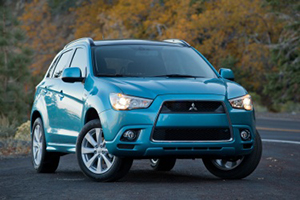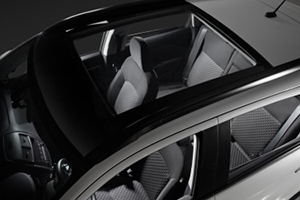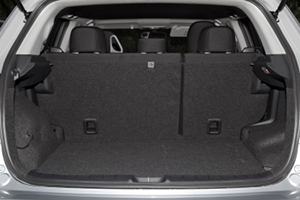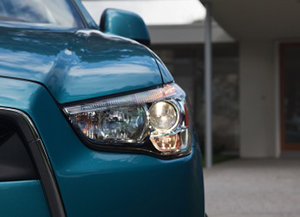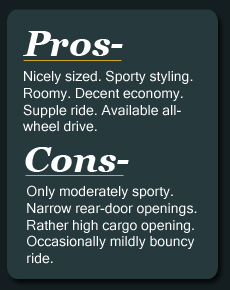2012 Mitsubishi Outlander Sport
Often-overlooked
2012 Mitsubishi Outlander Sport is an efficient crossover vehicle
Prices: $18,795-$23,295
“Mitsubishi” and
“often-overlooked” long have belonged in the same
sentence. The automaker lacks the advertising firepower, dealer number
and model-loaded product line of better-known nameplates in America.
But Mitsubishi has come up with innovative models, and so what if its
vehicles aren’t on everyone’s shopping list? Some
folks don’t want to drive the same vehicles they see coming
and going all the time, which include Outlander Sport rivals such as
the Honda CR-V and Toyota RAV4.
Don’t confuse the aggressively styled Outlander Sport with
the larger Mitsubishi Outlander. For instance, compared to the
Outlander, it’s more than a foot shorter and
doesn’t have a third-row seat. However, they share the same
105.1-inch wheelbase.
At approximately 3,000 pounds, the Outlander Sport is one of the
lightest vehicles in its class. It’s a sporty looking
crossover with chiseled aerodynamic bodywork and an aggressive looking
“shark nose” front end from the hot Lancer
Evolution sports sedan. It’s mainly aimed at those who want
an affordable, fairly fuel-stingy utility vehicle that looks good.
The Outlander Sport was introduced for 2011 and has become one of
Mitsubishi’s top-sellers. Improvements for 2012 include
recalibrated engine and transmission mapping, new wheel designs and
improved engine noise management.
Estimated fuel economy with the manual-transmission version is 24 miles
per gallon in the city and 31 on highways. The numbers with the CVT are
25 and 29. Those figures are pretty good for a crossover. High fuel
economy isn’t a strong point of any crossover.
Outlander Sport prices range from $18,795 for the base front-drive
manual-transmission ES model, which I tested, to the top-line $23,295
SE with all-wheel drive and a continuously variable automatic
transmission (CVT).
You can equip the front-drive ES with the CVT for $19,795. And a
front-drive version of the front-drive SE with the CVT lists at $21,995.
The Outlander Sport is the most fun to drive with its five-speed manual
transmission. It’s one of few crossover/smaller SUVs to offer
such a transmission, which has a precise shifter that works with a good
clutch.
The transmission shifts accurately, with well-defined gates, but the
fastest freeway/highway passing must be done in third gear, although
fourth will do if you’re not in too much of a hurry.
Third gear also is best for quick moves in city traffic. Fifth is
strictly an overdrive open-road gear.
The Outlander Sport with the CVT doesn’t isn’t
quite as lively as the manual-transmission version, especially with the
all-wheel drive feature, and the engine is a bit noisier during fast
acceleration.
The base ES has air conditioning, steering-wheel-mounted cruise control
and audio switches, AM/FM/CD/MP3 head unit, telescopic steering column,
keyless entry, a 60/40 split fold-down rear seat and power windows,
locks and large, heated power mirrors.
The SE adds such items as the CVT transmission, climate control and
wider aluminum wheels.
Options include a panoramic glass roof, navigation system with a
rearview camera and a sport package with a larger rear spoiler.
Safety items include lots of air bags, including a driver knee air
bag.
The Outlander Sport shares its basic underpinnings, powertrain and
other components with Mitsubishi’s entry level sedan, which
gives it a carlike driving feel.
Power comes from a 2-liter four-cylinder engine with 148 horsepower and
145 pound-feet of torque available across a wide powerband. The
sophisticated engine has dual overhead camshafts and variable valve
timing, although some might want more power if the Outlander Sport is
loaded with passengers and cargo.
The electric power steering is precise. And the all-independent
suspension provides a supple ride, which occasionally gets a little
bouncy on uneven pavement. Handling is good, with a stability control
system helping out. There’s noticeable body lean when driving
fast on curving freeway ramps, but the Outlander Sport hangs right in
there.
The all-disc brake setup has good pedal feel and electronic brake force
distribution for surer stops.
The quiet, average-looking interior has supportive front seats and
easily read gauges and user-friendly dashboard controls, although some
audio controls are small. Front door pockets have bottle holders. Front
cupholders are nicely placed in the console. But my test model
wasn’t equipped with a rear center arm rest containing
cupholders—although the armrest is available.
There’s decent room for four tall occupants in two rows of
seats. They sit high, although the step-in height is reasonable.
However, narrow door openings make it more difficult to slide in or out
of the rear.
The cargo opening is wide, but rather high for quick loading or
unloading. The cargo area is moderately roomy, and seatbacks flip
forward and sit flat for an impressive increase in cargo space.
The Outlander Sport has drawn more folks to Mitsubishi showrooms, which
need all the buyers they can attract.
